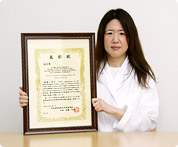- Suntory Global Innovation Center
- > Research & Technology
- > First in the world! Challenge for "blue roses"
- > Received the Excellent Paper Award of the Japanese Society for Plant Cell and Molecular Biology!
Research & Technology

Received the Excellent Paper Award of the Japanese Society for Plant Cell and Molecular Biology!
Suntory was awarded with the 2007 Excellent Paper Award of the Japanese Society for Plant Cell and Molecular Biology for a paper describing research achievements concerning methods to suppress plant gene functions. The award was presented to excellent papers (two papers this year) from among papers published in "Plant Biotechnology," an official English journal of the said society, in 2006. In the past, Suntory was presented with a Special Award and an Award for Technical Advance from this society for the development of blue roses and other products. The award this year was presented not only because of the technical development for commercialization but also because scientific findings that formed the basis of the development were published in an excellent English paper.

- Subject paper
- RNAi suppression of the anthocyanidin synthase gene in Torenia hybrida yields white flowers with higher frequency and better stability than antisense and sense suppression.
Plant Biotechnology (2006) 23:13-18
- Authors
- Noriko Nakamura, Masako Mizutani, Kiyoshi Miyazaki, Ken-ichi Suzuki, Yoshikazu Tanaka
- Abstract of the paper
- Development of varieties to produce new flower colors is commercially essential. Flower colors are also useful as an endpoint to monitor, at a glance, whether genes are functioning properly. Thus, studies on flower colors have been conducted actively for many years.
Down-regulation of a gene is often necessary to generate plants with target characteristics. The replacement (knockout) of a homologous gene has been performed to down-regulate gene functions in yeast and mice. However, the knockout of a gene is still difficult in higher plants, and the method of suppressing the function of a target gene by decomposing transcript (mRNA) is widely used. For this purpose, (1) the antisense method and (2) the sense method (co-suppression method) have been used, but more recently, (3) the RNAi method has become widely used. Using the sense method, Suntory had already produced white torenia by suppressing the function of enzymatic genes synthesizing pigments, but the frequency of white torenia production was low and its flower color was not consistent. In this study, we suppressed the expression of the anthocyanin-synthesizing enzyme genes in torenia producing blue flowers, using the abovementioned three methods, and examined which method would suppress the expression of the target genes most efficiently, using the frequency of white flower production as an endpoint. Using respective methods, we produced about 100 independent plants of transgenic torenia. About half of the plants gave white flowers by (3), while (1) and (2) yielded a few and no white flowers, respectively. The white flower color obtained by RNAi in some plants was stable for three years in a greenhouse. This study shows the usefulness of RNAi to suppress the expression of a target gene.
* The department name, title, and photo are as of the time of the production (interview).
* The department name, title, and photo are as of the time of the production (interview).
